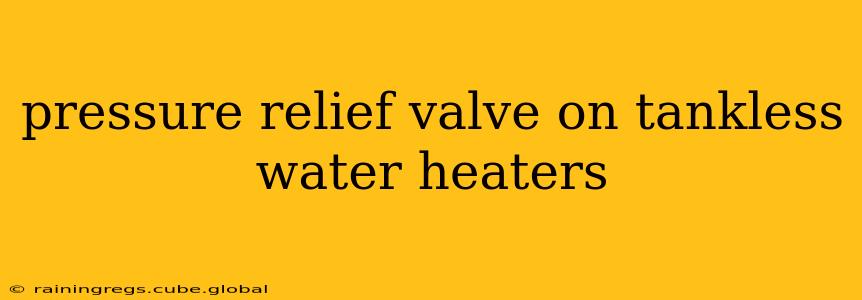Tankless water heaters, while offering numerous benefits like endless hot water and energy efficiency, also require careful maintenance. A crucial component is the pressure relief valve (PRV), a safety device designed to protect your system from dangerously high water pressure. Understanding its function, location, and maintenance is crucial for safe and efficient operation. This guide will delve into everything you need to know about the pressure relief valve on your tankless water heater.
What is the Pressure Relief Valve (PRV) on a Tankless Water Heater?
The pressure relief valve (PRV), also sometimes called a temperature and pressure relief valve (T&P valve), acts as a crucial safety mechanism. It's designed to automatically release excess pressure and temperature buildup within your tankless water heater system. This prevents potentially hazardous situations like explosions or severe water damage. High pressure can result from several factors, including excessive water pressure from the municipal supply, thermal expansion of water as it heats, or a malfunction within the heater itself. The PRV releases this excess pressure, ensuring the system remains safe.
Where is the Pressure Relief Valve Located?
The PRV's location varies slightly depending on the specific tankless water heater model and manufacturer. However, it's typically located near the water inlet and outlet connections of the unit. It's usually a small valve, often with a lever or handle, and might have a small pipe extending from it to drain excess water safely outdoors. Consult your water heater's installation manual for the exact location on your specific model.
How Does the Pressure Relief Valve Work?
The PRV operates on a simple principle: when the pressure within the tankless water heater exceeds a preset limit (usually around 150 PSI), the valve opens automatically, releasing hot water and reducing the pressure. This prevents the system from exceeding its safe operating pressure. Some PRVs are temperature-activated as well, opening if the water temperature reaches dangerously high levels. Once the pressure returns to normal, the valve automatically closes, preventing further water loss.
What Happens if the Pressure Relief Valve is Malfunctioning?
A malfunctioning PRV is a serious safety concern. If the valve fails to open when pressure exceeds the safety limit, it risks causing significant damage to the water heater and potentially your home. Signs of a malfunctioning PRV can include:
- Leaking valve: A small drip is usually acceptable after testing; however, a continuous leak indicates a problem.
- Difficulty operating the lever: If you can't easily move the test lever, the valve might be jammed or sticking.
- No water release during pressure test: If you manually activate the valve and no water is released, the valve may be clogged or faulty.
Never ignore a malfunctioning PRV. Immediate professional attention is recommended.
How Often Should I Test the Pressure Relief Valve?
While the frequency isn't strictly regulated, it's good practice to test your PRV at least once a year. This simple test ensures the valve is functioning correctly and can protect your system from potentially dangerous situations. To test it, simply lift the lever on the valve. Water should flow briefly and then stop. If not, there is a high probability of a malfunction.
What Causes High Pressure in a Tankless Water Heater?
Several factors can lead to high pressure within a tankless water heater system:
- High incoming water pressure: Your home's water pressure might be too high, exceeding the safe operating pressure of your water heater.
- Thermal expansion: As water heats, it expands. This expansion can increase pressure within the system.
- Clogged pipes or lines: Restricted water flow can also lead to pressure build-up.
- Malfunctioning pressure regulator: A faulty pressure regulator in your home's plumbing system could contribute to excess pressure.
How to Prevent High Pressure in a Tankless Water Heater?
Preventing high pressure is crucial for the longevity and safety of your system:
- Install a pressure regulator: If your home's water pressure is excessively high, a pressure regulator is a valuable investment.
- Regular maintenance: Routine inspections and maintenance can help identify and address potential issues before they become serious problems.
- Check for leaks: Leaks in the system can also affect pressure. Address any leaks promptly.
Can I Replace the Pressure Relief Valve Myself?
While replacing a PRV might seem simple, it's recommended to consult a qualified plumber or technician for replacement. Incorrect installation can compromise the safety of the system. A professional possesses the expertise to ensure the valve is correctly installed and functioning correctly, protecting your home and investment.
By understanding the role and maintenance of the pressure relief valve, you can ensure the safe and efficient operation of your tankless water heater for many years to come. Remember, safety should always be the top priority.
